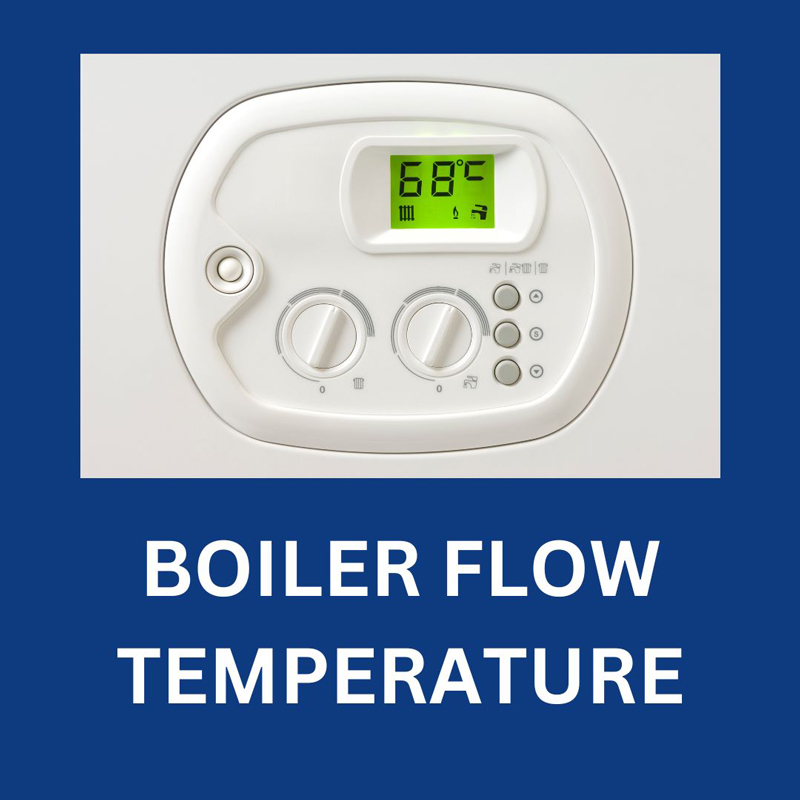
Boiler flow temperature refers to the heat of the water that exits the Boiler and circulates through a home’s heating system, such as radiators or underfloor heating.
The ideal Boiler flow temperature varies depending on the system type and external conditions but generally ranges between 60 °C and 70°C for radiator systems to effectively warm the space. Due to the larger surface area, a lower temperature between 40°C and 50 °C is sufficient for underfloor heating, providing comfortable heat without wasting energy.
Adjusting and maintaining the correct flow temperature helps enhance energy efficiency, extend Boiler life, and improve home comfort.
Introduction
Understanding your Boiler flow temperature is essential for optimising your home heating system’s efficiency and comfort.
Boiler flow temperature refers to the heat of the water circulating through your heating system’s radiators or underfloor heating pipes.
Understanding how to adjust and optimise your Boiler’s flow temperature can lead to substantial energy savings and enhance the longevity of your heating system.
What is Boiler Flow Temperature?
Boiler flow temperature is the water that exits the Boiler and circulates through your home’s radiators or underfloor heating pipes.
The specific temperature can vary depending on the type of Boiler, the settings, and external weather conditions.
Your Boiler’s thermostat or a central heating control system controls this temperature, which adjusts the heat output based on your preferences and needs.
The flow temperature is not static. It can be adjusted to suit different conditions. For instance, you might increase the flow temperature during a particularly cold winter day to ensure your home stays warm. Conversely, lowering this setting on milder days can help reduce energy consumption without sacrificing comfort.
Importance Of Maintaining The Correct Flow Temperature
Maintaining the correct flow temperature is important for several reasons:
- Energy Efficiency: Properly adjusted flow temperatures ensure that your Boiler operates efficiently, reducing wasted energy and helping to lower your heating bills.
- Comfort: An optimal flow temperature helps maintain a consistent and comfortable indoor environment, avoiding the extremes of too hot or cold.
- Boiler Health: Setting the flow temperature correctly can also extend the life of your Boiler by preventing it from working too hard, which increases wear and tear over time.
- Environmental Impact: Efficient boilers consume less fuel and produce fewer emissions, making your home more environmentally friendly.
Ideal Boiler Flow Temperatures
Finding the right balance in your Boiler’s flow temperature is key to maximising your heating system’s efficiency and your home’s comfort. Understanding what constitutes an ideal and best boiler flow temperature can help you make informed adjustments that suit your needs.
For Radiator Systems
A typical flow temperature is between 60- 70°C, especially during the colder months. This temperature ensures that radiators can emit sufficient heat to effectively warm the space. 60°C ensures better energy efficency than 70°C but may not provide enough heat for those who feel the cold more.
For Underfloor Heating
Since underfloor heating covers a larger surface area and is typically more efficient at distributing heat, a lower flow temperature of 40°C to 50°C is often ideal. This range provides comfortable heat without overheating the space or wasting energy.
Personalised Factors
The best flow temperature for your Boiler is not a one-size-fits-all setting but rather one that considers personalised factors such as your daily routine, comfort preferences, and energy savings goals:
- Seasonal Adjustments: Adjust the flow temperature based on seasonal changes. Lower temperatures are typically adequate in milder weather, helping to conserve energy.
- Occupancy Patterns: Consider lowering the flow temperature when the house is empty for long periods (e.g., during the workday) and only increase it to ensure comfort when the house is occupied.
- Thermostatic Controls: Using thermostatic radiator valves (TRVs) or smart thermostats allows you to set different room temperatures, optimising comfort and efficiency. For example, you might prefer a warmer temperature in living areas and a cooler bedroom setting.
Balancing these factors effectively requires some experimentation and adjustment over time. Observing how your home reacts to different settings during various weather conditions and times of day will guide you in finding the most effective flow temperature for your needs.
Tips For Optimising Boiler Flow Temperature
- Regular Maintenance: Ensure your Boiler and heating system are serviced to maintain optimal performance. A well-maintained boiler can operate more efficiently at lower temperatures.
- Upgrade Insulation: Improving your home’s insulation can reduce the need for higher flow temperatures as less heat will be lost, allowing you to comfortably lower the boiler settings.
- Consult a Professional: If unsure about the best settings for your system and home layout, consult a heating engineer.
Understanding and managing the ideal and best Boiler flow temperatures will enhance your home’s comfort and efficiency while minimising energy consumption and environmental impact.
Adjusting Boiler Flow Temperatures
Adjusting your Boiler’s flow temperature is a practical step towards optimising your heating system’s efficiency and comfort. Here’s how to reduce, check, and fine-tune the temperature to better suit your needs.
Consult the User Manual
For specific instructions on adjusting the flow temperature, consult your Boiler’s user manual. Most modern boilers have a control panel where you can make this adjustment directly.
Adjust the Thermostat
Lower the setting on your Boiler’s thermostat gradually. A good rule of thumb is to start by decreasing the temperature by 5°C, observing the impact on your comfort and heating bills, and then adjusting again if necessary.
Use Programmable Controls
If your system includes a programmable thermostat or smart home system, use it to set lower temperatures when less heating is needed, such as at night or when the house is empty.
Monitor & Adjust
Finding the optimal setting that balances comfort with efficiency may take several attempts. Over the next few weeks, monitor the indoor temperature and energy consumption and adjust as necessary.
FAQs
Here are some typical Boiler Flow Temperature FAQ’s:
How often should I adjust my Boiler flow temperature?
Typically, adjusting your boiler flow temperature seasonally is sufficient—higher in winter for comfort and lower in warmer months to save on energy. However, adjustments might be needed more frequently if significant weather changes or new heating patterns are established in your home.
What should I do if my Boiler flow temperature doesn’t change?
First, ensure you use the correct controls and follow the manufacturer’s instructions. If the temperature doesn’t change, it might indicate a malfunction with the thermostat or the Boiler’s control panel. In this case, it is best to contact a Boiler engineer for an assessment.
Can adjusting the flow temperature impact my Boiler’s warranty?
Adjusting the flow temperature within the manufacturer’s recommended settings won’t affect your warranty. However, modifications beyond these recommendations or DIY repairs could void your warranty.
Troubleshooting Tips
Here are some Boiler flow Temperature troubleshooting tips:
Inconsistent Heating
If you notice uneven heating in your home, check that all radiators are properly bled and the Boiler pressure is within the recommended range. Also, verify that the flow temperature is set correctly for the type of heating system you have.
Boiler Overheating
An overheating boiler can be due to a too-high flow temperature setting. Try lowering the temperature incrementally to see if it resolves the issue. If overheating persists, it may be due to a more serious problem, and a professional should be consulted.
No Change In Temperature After Adjustment
Ensure the adjustments are saved or applied correctly on your control system. If you’re using a digital thermostat, it might need recalibrating or replacing if it fails to communicate changes to the Boiler.
Energy Bills Still High After Lowering Temperature
If reducing the flow temperature doesn’t affect your energy bills, consider other factors like insulation quality, window and door seals, or additional heat losses in your home. A home energy audit can identify other areas where efficiency can be improved.
Need Help With Your Boiler Flow Temperature?
Please contact us if you live in Essex and require help with your Boiler flow temperature or anything else plumbing/heating related.

Hi, I’m Terry, the founder and owner of TM Hughes & Son Gas Services
Please get in touch to book an appointment or receive a free, no-obligation quote
Call – 01245 830075
Email – info@tmhughesandson.uk
Get A Free Boiler Quote
0% Finance
For Boiler Installations
